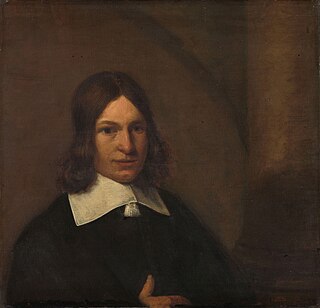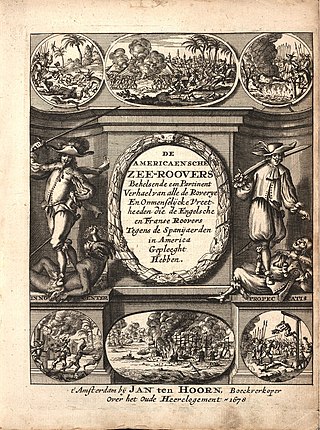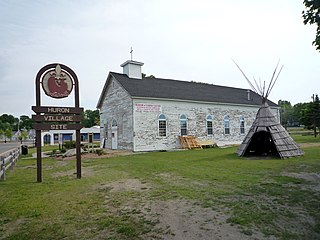
René-Robert Cavelier, Sieur de La Salle, was a 17th-century French explorer and fur trader in North America. He explored the Great Lakes region of the United States and Canada, and the Mississippi River. He is best known for an early 1682 expedition in which he canoed the lower Mississippi River from the mouth of the Illinois River to the Gulf of Mexico; there, on 9 April 1682, he claimed the Mississippi River basin for France after giving it the name La Louisiane. One source states that "he acquired for France the most fertile half of the North American continent". A later ill-fated expedition to the Gulf coast of Mexico gave the United States a claim to Texas in the purchase of the Louisiana Territory from France in 1803. La Salle was assassinated in 1687 during that expedition.

Henri de Tonti, also spelled Henri de Tonty, was an Italian-born French military officer, explorer, and voyageur who assisted René-Robert Cavelier, Sieur de La Salle, with North American exploration and colonization from 1678 to 1686. de Tonti was one of the first explorers to navigate and sail the upper Great Lakes. He also sailed the Illinois and the Mississippi, to its mouth and thereupon claimed the length of the Mississippi for Louis XIV of France. He is credited with founding the settlement that would become Peoria, Illinois. De Tonti established the first permanent European settlement in the lower Mississippi valley, known as Poste de Arkansea, making him "The Father of Arkansas."

A tontine is an investment linked to a living person which provides an income for as long as that person is alive. Such schemes originated as plans for governments to raise capital in the 17th century and became relatively widespread in the 18th and 19th centuries.

Pieter de Hooch (Dutch:[ˈpitərdəɦoːx], also spelled "Hoogh" or "Hooghe"; 20 December 1629 – after 1683, was a Dutch Golden Age painter famous for his genre works of quiet domestic scenes with an open doorway. He was a contemporary, in the Delft Guild of St. Luke, of Jan Vermeer with whom his work shares themes and style. De Hooch was first recorded in Delft on 5 August 1652, when he and another painter, Hendrick van der Burch witnessed the signing of a will. He was active in 1683, but his date of death is unknown.

Jan Davidsz. de Heem or in-full Jan Davidszoon de Heem, also called Johannes de Heem or Johannes van Antwerpen or Jan Davidsz de Hem, was a still life painter who was active in Utrecht and Antwerp. He is a major representative of that genre in both Dutch and Flemish Baroque painting.

Alexandre Olivier Exquemelin was a French, Dutch, or Flemish writer best known as the author of one of the most important sourcebooks of 17th-century piracy, first published in Dutch as De Americaensche Zee-Roovers, in Amsterdam, by Jan ten Hoorn, in 1678.
Pierre Alphonse de Tonty, or Alphonse de Tonty, Baron de Paludy was an officer who served under the French explorer Cadillac and helped establish the first European settlement at Detroit, Michigan, Fort Pontchartrain du Detroit on the Detroit River in 1701. Several months later, both Cadillac and Tonty brought their wives to the fort, making them the first European women to travel so deep into the new territory.

Joseph-Antoine le Fèbvre, sieur de La Barre was a French lawyer and administrator best known for his disastrous three years as governor of the colony of New France (Quebec).

The Wrong Box is a 1966 British comedy film produced and directed by Bryan Forbes from a screenplay by Larry Gelbart and Burt Shevelove, based on the 1889 novel The Wrong Box by Robert Louis Stevenson and Lloyd Osbourne. It was made by Salamander Film Productions and distributed by Columbia Pictures.

François Bernier was a French physician and traveller. He was born in Joué-Etiau in Anjou. He stayed for around 12 years in India.

Fort de Buade was a French fort in the present U.S. state of Michigan's Upper Peninsula across the Straits of Mackinac from the northern tip of lower Michigan's "mitten". It was garrisoned between 1683 and 1701. The city of St. Ignace developed at the site, which also had the historic St. Ignace Mission founded by Jesuits. The fort was named after New France's governor at the time, Louis de Buade de Frontenac.

Something Fishy is a novel by P. G. Wodehouse, first published in the United Kingdom on 18 January 1957 by Herbert Jenkins, London and in the United States on 28 January 1957 by Simon & Schuster, Inc., New York, under the title The Butler Did It.
Tonti or de Tonti may refer to:
Jacobus van Cortlandt (1658–1739) was a wealthy Dutch-born American merchant, slave owner, and politician who served as the 30th and 33rd Mayor of New York City from 1710 to 1711 and again from 1719 to 1720.
Louis-Henri de Baugy, Chevalier de Baugy was from a noble family of France and came to New France as a member of the party of Joseph-Antoine de La Barre, who was replacing Buade de Frontenac as Governor General.
Sir Robert Marsham, 4th Baronet was an English politician who sat in the House of Commons from 1698 to 1702.
Tontine was a British Thoroughbred racehorse and broodmare who won the classic 1000 Guineas at Newmarket in 1825. When the other horses entered in the race were withdrawn, Tontine became the only horse to win a classic by walkover. In a racing career which lasted from April 1825 until April 1826 she ran eight times and won three races. Unlike many of her near relatives, Tontine made no impact as a broodmare.
Pierre-Charles de Liette was an Italian who moved to French North America and enrolled there as a French soldier. He served as an aide to Henri de Tonti, as commandant at Fort Saint-Louis and Chécagou, and as a captain in the colonial regular troops from 1687 to 1729. He was also Commandant of the Illinois Country from 1702 to 1718.
Chicago and its suburbs have a historical population of Italian Americans. As of 2000, about 500,000 in the Chicago area identified themselves as being Italian descent.










